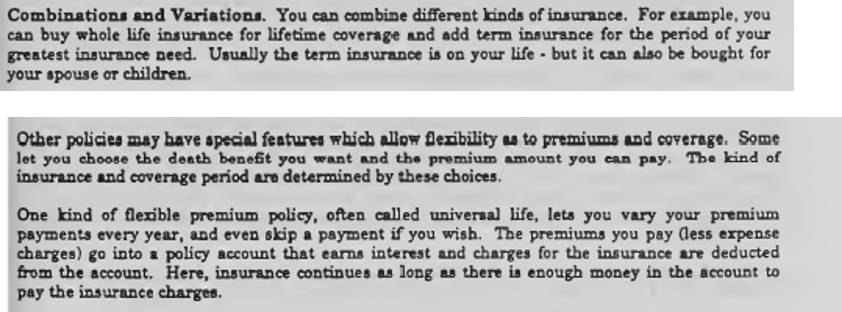NAIC - LIBG - Life Insurance Buyer's Guides - Comparison Chart
Words and Concepts
1976
1984
1990s
2000
2018
Scribes - Writers
Life Disclosure Working Group - Chair: Bob Wilcox (UT)
1996-1 NAC Proc. - Mr. Dunlap said that a small group consisting of Mr. Higgins, Brenda Cude (University of Illinois Cooperative Extension Service), and Chris Kite (FIPSCO) and himself had rewritten the buyer's guide (Attachment One-C).
Life Insurance Buyer's Guide Working Group - Chair: Mary Mealer (MO)
Types of Policies
There are three
basic kinds of life insurance.
1. Term insurance
2. Whole life insurance
3. Endowment insurance
A wide variety of plans being offered today.
- Here is a brief description of two basic kinds - term and whole life and some combinations and variations.
- Special Plans - Universal Life
There are two basic types of life insurance:
- term insurance and cash value insurance.
There are two basic types of life insurance:
- term insurance and cash value insurance.
There are many types of life insurance policies.
Term - Cash Value
<Bonk: No mention of Term having or not having Cash Value>
It generally does not build up cash value.
Term - Cash Value
Term insurance generally has lower premiums in the early years, but does not build up cash values that you can use in the future.
Most term policies don’t build up cash values that you can use in the future.
Most term policies have no cash value.
Premiums
Even if there is enough in your account to pay the premiums, continuing to pay premiums yourself means that you build up more cash value.
- Life insurance pays a death benefit if you die while the policy is in effect, in exchange for premiums you pay before your death.
- You typically pay premiums for whole life insurance according to a set schedule.
- In a universal life policy, you can choose a flexible premium payment pattern as long as you pay enough to keep your policy in force
- Can you afford the initial premium? If the premium increases later, will you still be able to afford it? The premiums for many life insurance policies are sensitive to changes in the company’s investment earnings, claims costs, and other expenses. If those are worse than expected, you may have to pay a much higher premium. Ask what might be the highest
premium you’d have to pay to keep your coverage. - • Do premiums or policy values vary from year to year?
• What part of the premium or policy value isn’t guaranteed? - • Have the premiums or benefits changed since your policy was issued?
Dynamic / Design your own
You might be able to change your present policy or even add to it to pc the coverage or benefits you now want.
Evaluate the Future of Your Policy
Ask your insurance agent, financial advisor, or an insurance company representative for an illustration showing future values and benefits.
Universal Life Insurance
Universal Life - Not Mentioned
- 1984 / 1993 - NAIC / ACLI Life Insurance Buyers Guide - 5p
- Other policies may have special features which allow flexibility as to premiums and coverage. Some let you choose the death benefit you want and the premium amount you can pay. The kind of Insurance and coverage period are determined by these choices.
- One kind of flexible premium Policy, often called universal life, lets you vary your premium payments every year and even skip a payment if you wish. The premiums you pay (less expense charges) go into policy account that earns interest and charges for the insurance are deducted from the account. Here, insurance continues as long as there is enough money in the account to pay the insurance charges.
There are two basic types of life insurance: term insurance and cash value insurance.
In a universal life policy, you can choose a flexible premium payment pattern as long as you pay enough to keep your policy in force.
Illustrations
Not Mentioned
Not Mentioned
Life Insurance Illustrations
- You may be thinking of buying a policy where cash values, death benefits, dividends or premiums may vary based on events or situations the company does not guarantee (such as interest rates).
- If so, you may get an illustration from the agent or company that helps explain how the policy works.
- The illustration will show how the benefits that are not guaranteed will change as interest rates and other factors change.
- The illustration will show you what the company guarantees.
- It will also show you what could happen in the future.
Life Insurance Illustrations
- You may be thinking of buying a policy where cash values, death benefits, dividends or premiums may vary based on events or situations the company does not guarantee (such as interest rates).
- If so, you may get an illustration from the agent or company that helps explain how the policy works.
- The illustration will show how the benefits that are not guaranteed will change as interest rates and other factors change.
- The illustration will show you what the company guarantees.
- It will also show you what could happen in the future.
Ask your insurance agent, financial advisor, or an insurance company representative for an illustration showing future values and benefits.
